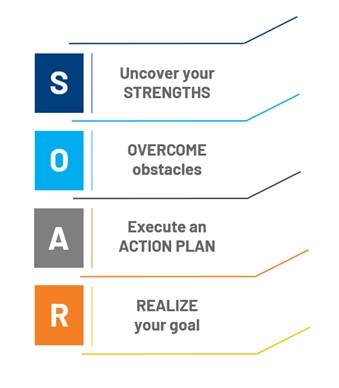A Coaching Model Created by Amy Sareeram
(Transformational Coach, CANADA)
Introduction
We often are told early in our lives to improve our weaknesses to be well-rounded individuals. This serves us well when we are children to learn fundamental skills and knowledge. It can also benefit us early in our careers as we learn what activities we enjoy and when we thrive.
As we progress throughout our life, we often continue to focus on our challenge areas. On its premise, this sounds like a reasonable action; however, this approach can lead us down a path of frustration if we produce limiting returns. Focusing on our strengths and enhancing those inherited capabilities we possess allows us to reach our full potential and achieve greater fulfillment.
This model helps clients realize their vision of a personal or professional goal. It can be used by high potential employees to unleash their full potential and those contemplating transitions to realize their ideal future.
SOAR Framework
 The SOAR framework walks clients through a process to realize their best self, soar to new heights, and reach their goals. When we are our best selves, we feel light, confident, empowered, and resolute in focus. Our previous successes and areas of enjoyment provide useful insights to unlock our future and achieve our best self.
The SOAR framework walks clients through a process to realize their best self, soar to new heights, and reach their goals. When we are our best selves, we feel light, confident, empowered, and resolute in focus. Our previous successes and areas of enjoyment provide useful insights to unlock our future and achieve our best self.
The process begins in working with the client to establish their intent and articulate their goal. It could be a larger life goal, professional goal, or personal goal. No matter what the goal, the role of the coach is to dig deeper and assist the client in understanding potential unknown drivers and associated aspects of the stated goal. The coach works with the client to visualize their goal, how it will feel, what it would look like, and why they seek that outcome. The coach can leverage a values exercise or other tools if the client has challenges in articulating the outcome they are seeking.
The coach then leads the client through the SOAR framework to achieve their goal.
S – Uncover Your Strengths
O – Overcome Obstacles
A – Execute an Action Plan to Unlock Your Potential
R – Realize your Goal
S – Uncover Your Strengths
The coach facilitates the client in identifying and understanding their strengths. Beginning with strengths is fundamental to the process. Rather than identifying obstacles, listing strengths deliberately focuses the client on the positive attributes they possess and increases confidence and energy toward their goal. Clients will develop a list of strengths, both currently known, and work to reveal strengths not easily apparent. Tools, such as Strengthfinders, can help uncover unknown strengths, and other tools, such Hogan or MBTI, can identify personality attributes to understand in which environments they may thrive.
The strengths step consists of more than just listing strengths. Time is also spent exploring how these strengths can be applied to achieve the overall goal as well as to overcome challenges the client may encounter along their journey. The coach employs Appreciative Inquiry to highlight how the client has the tools and capability needed to achieve their goal. The coach’s role is to create an environment that fosters empowerment and positivity to allow the client to see new ways of thinking based on employing their strengths and new opportunities to pursue their goal.
Example Questions:
- What things come easily to you?
- What activities bring you joy?
- When do you feel at your best?
- In which environments do you thrive?
- How would you describe yourself to others?
- What gives you satisfaction?
- What abilities or skills have you used successfully?
- How have you overcome obstacles presented to you?
O – Overcome Obstacles
Enabling success requires identifying potential obstacles that could pop up along the way. Some obstacles are known impediments; these are normally easier for the client to identify. The coach must also work with the client to uncover the unknown barriers in the client’s underlying beliefs and assumptions. Through questions, the coach can lead the client through ways to reframe these limiting beliefs and assumptions to realize their goal. We are often our own worst enemy in limiting our potential. Understanding their sources of doubt, fear, and self-expectations will allow clients to reframe their views so they can more fully embrace the goal they seek.
The coach will assist the client in understanding ways to employ their strengths to overcome the challenges they may face in implementation. For example, leveraging emotional intelligence skills to assess how to best mitigate difficult conversations or utilizing data to calculate risk and overcome fear in decision making. By framing obstacles as challenges that provide opportunities for demonstrating strengths, the coach assists the client in feeling confident, strong, and empowered to move toward their goal.
Example Questions:
- What internal factors may limit your ability to achieve your goal?
- What tools do you have that can be used to overcome this challenge?
- How else can you think about this?
- What evidence do you have to support that belief?
- What would it look like if nothing was holding you back?
- How is that thought serving you?
- If you were an observer to your life, what would you tell yourself to do?
- What attributes or skills can you leverage to unlock this barrier?
A – Execute an Action Plan to Unlock Your Potential
In this step, the client creates a clear path forward to their stated goal. The coach works with the client to craft concrete actions or steps that will enable them to move forward. The coach must understand their client and apply known strengths and weaknesses to challenge clients in developing a plan that will enable their success. For some clients, this may mean very small steps initially to gain confidence and momentum to alleviate or overcome fear. For those who may place unrealistic expectations or significance on perfection, it may mean discussing expectations and dealing with setbacks. For action-orientated clients, this may first come easily; however, it may require spending time to understand the sources of emotions and beliefs that may fuel the challenges to the actions.
Although the client will identify the actions themselves, the coach facilitates self-discovery and offers observations to ensure the client completes the identified actions. Along with identifying obstacles to implementation, a realistic timeline and accountability measures will be generated by the client. The coach will leverage visualization (using multiple or the most appropriate senses) to associate goals with sought emotions and results.
Example Questions:
- What are the first steps needed to achieve your goal?
- What do you need to enable your success?
- What challenges will appear?
- What self-imposed expectations may present themselves?
- What strengths do you have to counter this?
- What do you need to hold yourself to do this?
- How will achieve this step feel?
- How does completing this action lead to your overall goal?
R – Realize the Goal
In this step, the client implements and achieves their stated goal. However, it is not the end of the journey; rather a place in time where the client realizes their original visualized future. Our goals and interests change as life changes. We encounter unexpected events that require us to re-evaluate. Sometimes what we sought is not what we expected. Clients consistently refine their visualized goals and can employ these steps to continue to achieve their new and desired goals.
Example Questions:
- What have you learned about yourself?
- What strengths can you leverage now to adjust to the new goal?
- What is needed to adapt?
References
The Art of Possibility by Rosamund Stone Zander and Benjamin Zander
International Coach Academy, ICF Module: Appreciative Inquiry
Strengthfinders Tool
Values Card Exercise
International Coach Academy, ICF Module: Values and Life Purpose
